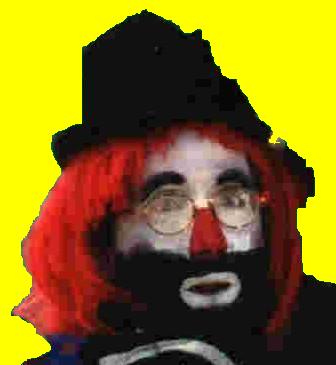

 Wheeler
Presents A Chronology of
Clowndom
Wheeler
Presents A Chronology of
Clowndom
1900 |
Civil War Era
clown and
Clown Hall of Fame inductee Daniel
"Yankee
Dan Rice" McLaren Jr. died
(born:1823
|
||||||||||||||||||||||||||||||||||
Clown Hall of Fame inductee and British circus great Nikolai "Coco" Poliakov was born in Russia. |
|||||||||||||||||||||||||||||||||||
1901 |
Clown Hall of Fame inductee and circus great Paul Jung was born in Dayton, Ohio USA. |
||||||||||||||||||||||||||||||||||
1902 |
Six year old Clown Hall of Fame inductee Charlie Rivels began performing a head balancing act with his sister who was one year younger. |
||||||||||||||||||||||||||||||||||
1903 |
Clown and Circus Halls of Fame inductee Jacob "Lou Jacobs" Ludwig was born in Wesermude, Bremerhaven, Germany.
The popular clown duo Brick and Brock split up due to Brock's military service, and Brick took on a new partner, Karl Adrian Wettach. Adrian. Karl so liked the name of his predecessor that he took the stage name of Grock. Grock thus began an illustrious career that led to his induction into the Clown Hall of Fame. |
||||||||||||||||||||||||||||||||||
1904 |
Emmett "Weary Willie" Kelly Sr. received the first spanking he could remember, for climbing a telephone pole and sitting on the crossbeam until his terrified mother and neighbors got him to climb halfway back down so that he could be rescued. According to Emmett Sr., the pole was much higher than the tent in which he later performed his first aerial act. |
||||||||||||||||||||||||||||||||||
1905 |
|
||||||||||||||||||||||||||||||||||
1906 |
Vitaly Lazarenko the Elder decided to become a
clown.
Prior to that he had
|
||||||||||||||||||||||||||||||||||
Clown Hall of Fame inductee Frankie Saluto was born. He was one of the little people. (a circus name for dwarf or midget performers) |
|||||||||||||||||||||||||||||||||||
1907 |
|
||||||||||||||||||||||||||||||||||
Michael "Karandash" Rumyantsev, Russia's most popular clown in the 1960s and 1970s, was born. (Karandash is Russian for pencil). |
|||||||||||||||||||||||||||||||||||
Clown Hall of Fame inductee Alphonse "Al Ross" Helwig was born in Cincinnati, Ohio. |
|||||||||||||||||||||||||||||||||||
|
|||||||||||||||||||||||||||||||||||
1908 |
Clown Hall of Fame inductee Bobbie Kaye was born. |
||||||||||||||||||||||||||||||||||
At the age of eight, Nikolai "Coco" Poliakov ran away from home to work for an organ grinder, beginning a career in entertainment that eventually led to his induction into the Clown Hall of Fame. |
|||||||||||||||||||||||||||||||||||
|
|||||||||||||||||||||||||||||||||||
1909 |
Clown Hall of Fame inductees the Fratellini Brothers began their trio clown act in France, inspired by their brother, Louis, (also a clown) who had died that year. Although Paul, the eldest, was a traditional auguste of that time period, Albert, the youngest, created a clown face that became the model for the present day Auguste clown. Francois was a traditional whiteface. |
||||||||||||||||||||||||||||||||||
click here to return to Clown history menu page Click Here to Return to Clown Main Menu
|